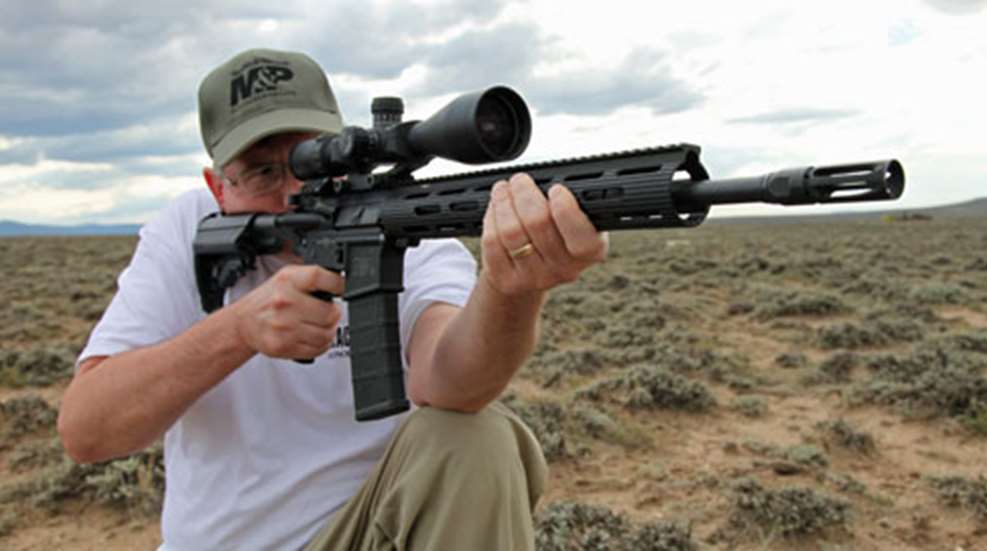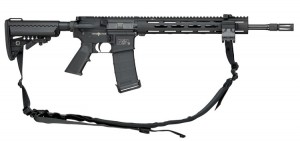
At least 20 wild hogs popped out of the west Texas mesquite and began trotting across a field some 80 to 90 yards to my right. A grey sow led the way, followed by a line of smaller hogs (not more than a few months old) and a couple medium-sized pigs. Bringing up the rear was a dark boar with a stout, triangular head and blocky shoulders. The way he took his time, you just knew: This big guy didn’t rush anywhere, for anyone.
I swung my Smith & Wesson VTACII rifle along the rail of my tripod stand, lined up the crosshairs of my scope on the mid-shoulder area, and squeezed off a shot. I followed with a fast follow up, even as the slab-sided hog jerked in the scope and began to sprint.
I fired twice more as he ran, both misses, as the hog was moving too fast and my heart suddenly beating too hard. He crossed behind a couple of trees, clearing them, his legs churning. As I tried to line up my scope on him, the boar hit the ground, tried to rise up, fell back and died.
At 90 yards with a broadside shot, any decent AR-style rifle could’ve made that first shot. But I also received some big assists with my successful second shot from this Smith & Wesson rifle. Assist One: Unlike a lot of AR’s on the market, the VTACII employs a mid-length gas system, meaning the VTACII’s gas tube is approximately 2 inches longer than the tube on a standard AR carbine system. That longer gas tube helps lessen the felt recoil by reducing the bolt carrier velocity. Less recoil equals faster follow-up shots.
Reason Two: The Geissele Super V Trigger that comes standard on the VTACII, a single-stage trigger with a 4- to 4.5-pound pull weight, is just about the smoothest AR trigger I have ever used.
Sitting 15 feet up in a tripod stand, my first bullet took the boar mid-shoulder and plunged down and through his heart-lung area. The next bullet hit him about 6 inches further back, not a kill shot but a solid follow up to help anchor him, a 310-pound west Texas boar.
I spent a good part of the summer in the field and on the range with the VTACII, and it is accurate, easy and fun to shoot, and light and nifty afield. It’s great for shooting, even better for hunting.
While I don’t do 3-Gun competitions, the rifle clearly has that 3-Gun look to it, especially with the 13-inch long VTAC/Troy Extreme TRX Handguard that allows for quick target transitions. The new handguard also helps to reduce heat transfer, while the multiple accessory slots provide many options for mounting accessories.
The rifle’s 16-inch barrel is constructed of 4150 CMV steel, has a 1:8-inch twist rate, and a Melonite finish. The rifle features 5R rifling, with five rifling grooves designed with more angular lands than most rifling. The 5R approach is designed to reduce bullet jacket deformation versus common sharper-edged lands, to reduce powder fouling at the corner of the grooves to maintain better accuracy and reduce copper fouling and cleaning times.
The barrel’s tipped with S&W’s patent-pending “Enhanced Flash Hider,” designed to significantly reduce flash signature and to direct gases and sound forward and away from the shooter.
The rifle also has a VLTOR IMod 6-Position, collapsible stock. It provides an excellent cheek weld that puts the face right at the correct eye level for the scope. A standard Picatinny rail runs along the top of the receiver and the handguard. Gas key and bolt carrier are chromed.
It also comes with a VTAC light mount, which fits most lights with a .80- to 1-inch diameter, and two, 2-inch adjustable Picatinny-style rails that can be mounted in the slots along the handguard. Rounding out the package are a VTAC Wide, Padded 2-Point Tactical Sling, a LPSM Low Profile Sling Mount and a 30-Round PMAG magazine.
Why so many “V’s” in the names and descriptors? Because the rifle’s the result of a collaboration between Smith and Wesson and U.S. Army Sgt. Maj. Kyle Lamb (retired), a veteran of Army special operations and owner of Viking Tactics. A highly sought after tactical trainer, Lamb’s also the driving force behind Viking’s tactical products and accessories, many of which adorn the VTACII.
I fitted the rifle with a Leupold Mark AR Mod1 3-9x40 mm scope, attaching it with Leupold’s Mark 2 Integral Mounting System. I used this scope and rifle combo for all my range sessions and hunting time afield.
One problem I have when trying out new AR’s is that I tend to pull off too many shots, too fast. That makes a barrel heat up pretty fast (though the Troy Handguard worked as advertised and kept my hand cool), and accuracy definitely starts to waver from a very hot barrel. So while I started with four- and five-shot groups for accuracy testing at 100 yards, I ended up relying on three-shot groups and trying to let the VTACII cool down a bit between ammunition switches. Three shots, I felt, presented a better and fairer test for both the rifle and the ammunition.
I tried out four different brands of .223 ammunition for accuracy testing. The best three-shot group was from Hornady’s Superformace Match shooting a 75-grain BTHP bullet. That ammunition consistently placed my groupings at 1 MOA or better, with the best three-shot string coming in at .780 of an inch.
Other .223 ammunition used, and their best groupings include: ASYM Precision with 70-grain SDX bullet, 1.25 inches; Dynamic Research Technologies 79-grain hollow-point bullets, 1.40 inches; and Remington Premier Match 62-grain hollow point, 1.55 inches.
I killed the boar with Remington’s new Hog Hammer .223 ammunition, which propels a 62-grain Barnes TSX bullet out of the muzzle at 3,100 fps. Some Hog Hammer arrived just before I headed out for my hog hunt, so I was able to quickly reset my scope’s zero with this new ammo-it had been sighted in with the Remington Premier Match- but I never formally tested accuracy with it.
I also didn’t use any ammunition with bullets under 62 grains. I do a good deal of hunting with AR’s in .223. So I tend to use and practice with .223 ammunition featuring the heavier, longer bullets that are better able to bring down medium- to larger-sized game animals.
Actually, my first experience with the VTACII occurred in July 2012, on a Wyoming prairie dog shoot. For ammunition, I shot Hornady 55-grain Zombie Max with green tips. The rifle/Z-Max combo was dead on all day long, with never a jam or misfire in 400-plus rounds.
In my more recent time with the VTACII, I put another 200 rounds through it. So, all in all, 600-plus rounds were fired through two different VTACII’s without a single jam, despite some very dusty conditions and switching between various ammo brands.
The only real problem with the VTACII is a suggested retail price of nearly $2,000. Yet, I know two people who’ve actually paid $400 less for their VTACII’s in a store. If you take a $900 AR and refit it with a new trigger, better handguards and stock, plus a tactical sling and light mount, you are looking at $1500 and maybe a bit more. With the VTACII, you are all ready to go.
Manufacturer: Smith & Wesson; Smith-wesson.com
Caliber: .223 Rem/5.56 NATO
Action: semi-auto, mid-length gas system
Receiver: 7075 T6 Aluminum
Barrel: 16”
Rifling: 1:8” 5R rifling
Magazine: 30-round PMAG
Sights: none
Trigger: 4 to 4.5 lbs.
Stock: polymer
Overall Length: 36.75 extended, 33.5” collapsed
Weight: 6.28 pounds
Accessories: VTAC wide padded, two-point sling; low profile sling mount; VTAC light mount.
Suggested Retail Price: $1,949






































